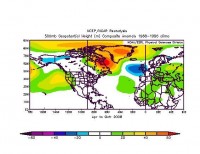By Joseph D’Aleo, CCM, AMS Fellow
In this story, NASA scientists suggested between 1.5 trillion and 2 trillion tons of ice in Greenland, Antarctica and Alaska have melted at an accelerating rate since 2003, in the latest signs of what they say is global warming. Using new satellite technology that measures changes in mass in mountain glaciers and ice sheets, NASA geophysicist Scott Luthcke concluded that the losses amounted to enough water to fill the Chesapeake Bay 21 times in a paper presented at the AGU conference.
The data reflects findings from NASA colleague Jay Zwally, who uses different satellite technology to observe changing ice volume in Greenland, the Arctic and Antarctica. In the past five years, Greenland has lost between 150 gigatons and 160 gigatons each year, (one gigaton equals one billion tons) or enough to raise global sea levels about .5 mm per year, said Zwally, who will also present his findings at the conference this week. GRACE measured that mountain glaciers in the Gulf of Alaska lost about 84 gigatons each year, about five times the average annual flow of the Colorado River through the Grand Canyon, according to Zwally.
The claims conflict with the reality that just recently glaciologist Bruce Molnia reported a bitterly cold Alaskan summer following a winter with extreme cold and record snows resulted in Alaska glaciers to expand, rather than shrink for the first time in at least 250 years.
Also in 2007, NASA scientists reported that after years of research, their team had assembled data showing that normal, decade-long changes in Arctic Ocean currents driven by a circulation known as the Arctic Oscillation was largely responsible for the major Arctic climate shifts observed over the past several years. These periodic reversals in the ocean currents move warmer and cooler water around to new places, greatly affecting the climate.
NSIDC also presented a paper at the AGU this week on the disappearing ice. In this BBC story, scientists say they now have unambiguous evidence that the warming in the Arctic is accelerating. Computer models have long predicted that decreasing sea ice should amplify temperature changes in the northern polar region. Julienne Stroeve, from the US National Snow and Ice Data Center (NSIDC), told a meeting of the American Geophysical Union that this process was under way.
Ironically just last year a NSIDC story correctly summarized the findings of many researchers and peer review papers that natural warming and cooling cycles in the Atlantic and Pacific were the real drivers for the cyclical changes in arctic ice over the centuries (as we have shown most recently here).
As for the Greenland melt. Though Greenland was very cold and icy last winter, high latitude blocking this spring and summer into the fall likely led to more melt. These blocks are favored by solar minimum westerly QBO conditions in summer. The block has been displaced south and east the last month allowing frigid conditions and snowfall to return.

See larger image of April to October 500m heights here. Orange and red are warm ridges. Note the warmth over Greenland, northeast Canada with cold trough Alaska (and UK)
Read much more on the Arctic and Greenland here.




